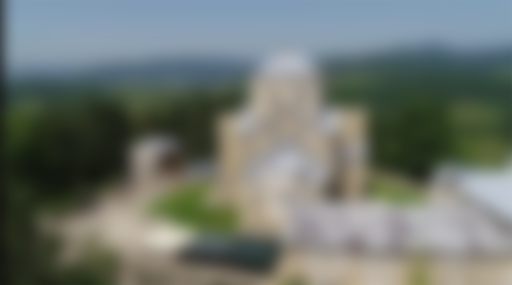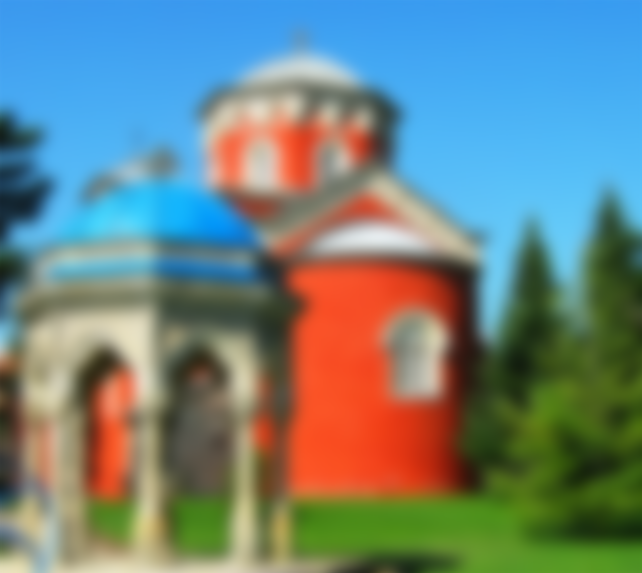
Among numerous Serbian dynasties, the greatest contribution to the Serbian state and people was made by the Nemanjić dynasty, which ruled for two centuries (1169-1371). In eight generations of Nemanjić, as many as there were males, of which we know more than sixty by name, we celebrate nineteen Nemanjićs as saints, and even more than this number, bearing in mind the female descendants.
The ancestor of Nemanjić is the great Raska prefect Stefan Nemanja, the son of Prince Zavida. Stefan Nemanja was connected with the Vukanovićs in the male line and with the Vojislavljevićs in the female line. There are eleven rulers in the dynasty, with the dynasty continuing along the side, female line into the Lazarević dynasty, and later Branković, who ruled part of the Serbs until the first half of the sixteenth century.

Raising endowments was a very widespread custom among Serbian rulers in the Middle Ages. In the Nemanjic state, starting from the great prefect Stefan Nemanja until the last, tsar Uroš, and then in the kingdom of Mrnjavčević and in the principality of Lazar Hrebeljanović, and finally, in the despotate of Stefan Lazarević and Đurđe Branković, every ruler tried to build at least one big church or monastery, and there were some who could build a dozen temples. In the 12th and 13th centuries, only rulers and their closest relatives were able to build endowments for themselves.The monasteries are supported by the property donated by the founders. The thought of the giver, often written in gift charters and quoted in inscriptions, was the atonement of sins: the saint to whom the temple was dedicated became the founder's intercessor before Christ in the terrible judgment.
Monasteries and churches also had a practical purpose, and not only the one always present to spread and strengthen the faith of the people. According to the geographical distribution, and they were built on the most important medieval roads, it can be concluded that they also had a political role. Some churches, in addition to the above, had another purpose - they represented temples in episcopal seats, church administrative centers. Zica and Peja became famous for that role, as the centers of the Serbian archbishopric, then the patriarchate. Finally, many monasteries were built to become the tomb churches of their founders.
All Serbian rulers of the royal family of Nemanjić left behind endowments, their churches and monasteries, to redeem their souls and show their greatness. I'll give you some of those endowments.
Đurđevi Stupovi

Đurđevi Stupovi in Stari Ras, one of the oldest monasteries in the former capital area of medieval Serbia, built by Stefan Nemanja in the first years after the accession of the great prefect, dominates the valleys of Raška and Deževa with its silhouette. It is located about 4 km northwest of Novi Pazar. The silhouette of an imposing dome planted on a mighty pedestal of columns, arches and walls looks magnificent - seen from tens of kilometers away. The monastery was built on the very top of a prominent hill, and the special architecture of the church of St. George with two bell towers - a pillar - determined the later name of both the church and the monastery - St. George's Pillars.
According to his biographer and son, the later Serbian king Stefan the First-Crowned, during his captivity in a cave, Nemanja vowed to build a temple and dedicate it to St. George, to whom he prayed for help several times during his life. After he took over the supreme power in the Serbian lands (1166), Nemanja began the construction of the monastery. The church was completed in 1171, as evidenced by the founder's inscription on the western portal of the temple. Somewhat later, around 1175, the church was painted, and the monastery immediately gained a great reputation as the first ruling endowment of the Nemanjić dynasty.
Although Stefan Nemanja built churches and monasteries as a regional ruler, the monastery of St. George in Ras represents a turning point in the ruling ideology of Nemanjić. In an exceptional position, not far from the cathedral of the Raska episcopate, on old spiritual foundations, this monastery bases the Christian idea of Serbian statehood - the idea of complete harmony of faith and state that Stefan Nemanja built into the fundamental values of Serbian society. Under his arches, the young Rastko Nemanjić also gained his first spiritual experiences.
Studenica

Studenica Monastery is one of the largest and richest monasteries in the Serbian Orthodox Church. It is located 57 km from Kraljevo, and was founded by Stefan Nemanja in 1190.
The fortified walls of the monastery surround four churches: the Church of the Mother of God and the King's Church (Church of Saints Joachim and Anna), both built of marble, the Church of St. Nicholas (Church of St. Nicholas) and another church, preserved in the foundations. The monastery is known for its collection of frescoes from the 13th and 14th centuries. In 1986, UNESCO included Studenica in the World Heritage List.
When he later went to the Hilandar monastery, Stefan Prvovenčani took care of Studenica. There, Nemanja received a monastic vow and the name Simeon. Saint Simeon died in Hilandar in 1199. Nemanja's third son Sava Nemanjić, after reconciling his brothers Stefan and Vukan, transferred the relics of Saint Simeon to Studenica, where they are still today. Under Sava's tutelage, Studenica became the political, cultural and spiritual center of medieval Serbia.
Hilandar

The Hilandar Monastery was built before the end of the 112th century by Simeon Nemanja and Sava Nemanjić with the help of the then King of Serbia, Stefan the First-Crowned. It is located in Greece, on the Holy Mountain, and is a frequent destination for occasional travelers.
Hilandar's heritage is timeless and extraterrestrial. Hilandar Monastery is the first Serbian university and one of the oldest in the world. Saint Sava himself is the founder of the Spiritual Academy of the Hilandar Monastery, which lives all the time, without stopping until today. In terms of literature, religion, the study of nature, medicine, by all criteria, it was a real university, which educated the best connoisseurs of that time. The monastery keeps the largest collection of Serbian charters, arks, relics of saints, relics, old icons, has the largest number of miraculous icons in the world, as many as eight, of which the most valuable and most respected:.the icon of the Mother of God Trojerucica, the icon of Christ Pantocrator, which is the most beautiful icon of Christ on the planet and the icon of the Virgin Hodegetria, which is considered the greatest masterpiece of Byzantine art of the thirteenth century. Here is the largest library of manuscripts of the Serbian people, the largest collection of copperplate and copperplate plates, old liturgical textiles, old church vessels, woodcarvings, porcelain, goldsmiths and the most beautiful church on the Holy Mountain according to Byzantine scholars.
The video shows him one day in Hilandar
Serbian literacy, translation and transcription activities were founded in Hilandar, the Serbian medieval legal state, diplomacy was conceived there and one of the first Serbian hospitals was founded. A place where Moravian architecture reaches its peak, through which the greatest artists of icon painting and fresco painting have passed for eight centuries. Until the 15th century, Hilandar owned over 30 large Metohijas in Europe and Asia with over 360 villages and a huge spiritual, human and material potential, which was measured by the strength of the state. In a word, what is preserved in Hilandar is bigger than all the preserved heritage in all other Serbian monasteries.
Žiča

Žića is a Serbian medieval monastery from the first half of the 13th century, located near Kraljevo. It was built by the first king of Serbia from the Nemanjić dynasty, Stefan Nemanjić, and his brother, Saint Sava, also played a significant role in its construction.
After gaining church independence in 1219, the seat of the autocephalous Serbian archbishopric was located in Žiča. At the beginning of the last decade of the 13th century, the monastery was attacked by the Tatars, after which the seat of the archbishopric was transferred to the Holy Apostles near Peja, and the monastery itself was restored by King Milutin at the beginning of the 14th century.
During the Middle Ages, bishops and kings from the Nemanjić dynasty were enthroned in Žiča, which is why it is also known as the "Seven Gates". Similarly, the main monastery church is dedicated to the Ascension of Christ (Holy Savior), so in professional writings it is also called the Church of the Savior, although this is mostly unknown.
What most people notice first when it comes to this imposing building is its color. Because, there are not many monasteries in Serbia, nor in the world that are so intensely red.
There is an interesting story about how this came about.

Namely, Žiča was raised by the first king of Serbia from the Nemanjić dynasty, Stefan Nemanjić, and his brother, Saint Sava, also played a significant role in its raising.
He stayed on the Holy Mountain for a while, and after returning from Nicaea to Serbia in 1220, he ordered certain changes in the architectural appearance of the church. In the third decade of the 13th century, the church was plastered and painted red
Art historians believe that this was exactly the idea of Saint Sava, who saw temples on the Holy Mountain, such as Lavra and Vatopedi, which were red. There he became acquainted with the belief that the church rests on the blood of martyrs and that it is symbolically brought to life in the color of the churches, and after that he demanded from the master to paint both Žiča in the same way.
These are just some of the endowments of Nemanjić. If you like the article about the writer and others.







wonderful written article dear....i like photos too